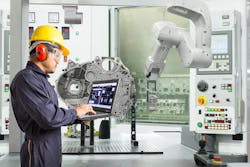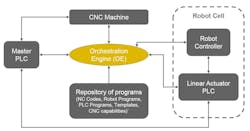Taking Industry 4.0 to Factory Floors With Advanced Automation
Industrial automation is old news. The ancient Egyptians used feedback controllers with water clocks over 2,000 years ago, long before they found their way into the manufacturing market in the 1930s.[1] Since then, the concept of automation has steadily grown to include mechanical, hydraulic, pneumatic, electro-mechanical, electrical, and computational systems.
Today, factory automation is primed to take a giant leap as technologies like artificial intelligence (AI) and computer vision inject themselves into operations technology (OT) in a system-wide update that we like to recognize as Industry 4.0.
Factory automation has become tremendously sophisticated—mechanical arms and robotics can operate machines, tools, and entire systems. For production lines, automation can improve a factory’s safety, productivity, response rate, and quality standards, while it reduces the time a company spends teaching workers hard-to-learn skills.
Intelligent Automation – One answer to many questions
We, at Wipro, have witnessed a vast change with our clients, especially in the automotive and telecommunications industry. In these sectors, computers have guided assembly line operation systems to load and integrate components, print entire circuit boards, inspect finished products, and pack containers for shipping.
Factory automation has become an increasingly broad concept. Assembly lines, machine tending, welding cells, inspection, warehousing, inventory tracking, and other processes can now all be automated.
When it comes to Computer Numerical Control machines (CNCs) which are used to drill, cut, grind, stamp, mill, and weld components, robots can feed machines with jobs (or components). However, most of the time, humans are required to set up changes like inserting the proper tools or loading the proper NC code into the machine.
These human tasks can significantly increase the idle time of an automation cell as it must come to a halt when humans have to intervene to make these changes in setup. Aside from these stoppages, the chances for errors increase with large or frequent setup changes, especially if the factory employees involved have not been adequately trained. Human error might include the wrong NC code, the wrong tool, or worse, the wrong output. Mistakes like these could put production managers behind schedule and lead to economic loss for the manufacturer. This is why this critical process needs to be automated.
Let’s assume that the manager is using an Enterprise Resource Planning (ERP) system from a remote location. Could that manager tell an automated system to change production lines, volumes or product quality based on real-time demand in a way that the factory would automatically change its entire process?
A smart and intelligent Orchestration Engine
We, at Wipro, have developed a system that can achieve complete automation on the factory floor, which reduces idle time and human error. An Orchestration Engine is at the heart of such an automated system. (see Figure 1: Automation of CNC Machine Tending).
The engine takes inputs from humans, like a manager connected to an ERP system, and uses templates and programs in its repository to interact with the Master Programmable Logic Controller (PLC) and updates the CNC machine based on production needs. In other words, the Orchestration Engine, or bot, makes dynamic decisions based on the current state of the job to achieve the objectives of Industry 4.0 by integrating IT and OT systems.
This newly automated system can be further improved by several magnitudes through the intelligent re-deployment of the Orchestration Engine. Typically, a CNC machine operates for 5 to 30 minutes. During this period, the bot is idle, therefore it can be used to tend to other CNC machines in the manufacturer’s facility. All that is required is for the bot to intelligently automate work across production rails or the gantry. The end result is a reduction in idle time, and a concurrent boost in utilization and their operational speed. The orchestrator is made to continuously learn from the process outcomes over time so it will be able to eventually predict potential production disruption.
Going one level higher
We can take the automation, intelligence, and ease-of-use one level higher.
Normally, a company orders a robot, the maker ships it to a facility to be trained in various processes and tests; then ships it to the company’s location, where it would finally be commissioned. Instead, we can train the robot in the virtual world and reduce the time and costs invested in logistics, thus allowing faster production. We can test millions of scenarios through simulations at speeds which are nearly impossible in the real world, meaning that we have tested most of the cases that could cause significant production disruptions before the machine is even on the factory floor.
We call this Virtual Commissioning. It is a method to train and test robots remotely in the virtual world and reduce the number of unknowns before commissioning.
The benefits of using advanced Industry 4.0 type automation in a factory environment are obvious: human operators may be based anywhere across the world, thus reducing the pressure on skills acquisition. Operations Technology teams will vouch for reduced costs and improved safety, and finally, it is more capable of responding to changing production needs.
About the Author

Hemachandra Bhat
Senior Delivery Manager, CTO Office, Wipro
Hemachandra Bhat has more than 30 years of experience in product development. He has led the development and deployment of many products that include personal computers; servers; System on Chips for automotive/ consumer applications; embedded systems for consumer applications. He has lead the development of AI solutions for banking, manufacturing, and FMCG customers as part of CTO’s office.
Bhat currently heads the Robotics practice in Wipro developing robotics solutions for manufacturing operations. He holds a Master’s Degree in Software Systems. He holds one patent granted and has two patents pending.

